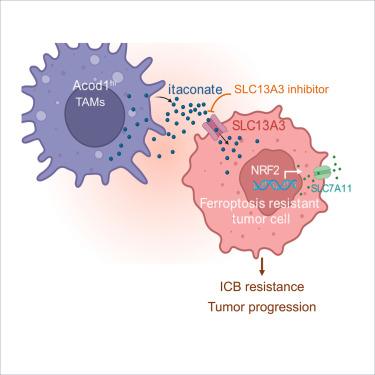当前位置:
X-MOL 学术
›
Cancer Cell
›
论文详情
Our official English website, www.x-mol.net, welcomes your
feedback! (Note: you will need to create a separate account there.)
Itaconate transporter SLC13A3 impairs tumor immunity via endowing ferroptosis resistance
Cancer Cell ( IF 48.8 ) Pub Date : 2024-11-07 , DOI: 10.1016/j.ccell.2024.10.010 Heng Lin, Kole Tison, Yuheng Du, Paul Kirchhoff, Chan Kim, Weichao Wang, Hannah Yang, Michael Pitter, Jiali Yu, Peng Liao, Jiajia Zhou, Linda Vatan, Sara Grove, Shuang Wei, Thomas Vigil, Yatrik M. Shah, Richard Mortensen, Ilona Kryczek, Lana Garmire, Jwala P. Sivaccumar, Weiping Zou
Cancer Cell ( IF 48.8 ) Pub Date : 2024-11-07 , DOI: 10.1016/j.ccell.2024.10.010 Heng Lin, Kole Tison, Yuheng Du, Paul Kirchhoff, Chan Kim, Weichao Wang, Hannah Yang, Michael Pitter, Jiali Yu, Peng Liao, Jiajia Zhou, Linda Vatan, Sara Grove, Shuang Wei, Thomas Vigil, Yatrik M. Shah, Richard Mortensen, Ilona Kryczek, Lana Garmire, Jwala P. Sivaccumar, Weiping Zou

|
Immune checkpoint blockade (ICB) triggers tumor ferroptosis. However, most patients are unresponsive to ICB. Tumors might evade ferroptosis in the tumor microenvironment (TME). Here, we discover SLC13A3 is an itaconate transporter in tumor cells and endows tumor ferroptosis resistance, diminishing tumor immunity and ICB efficacy. Mechanistically, tumor cells uptake itaconate via SLC13A3 from tumor-associated macrophages (TAMs), thereby activating the NRF2-SLC7A11 pathway and escaping from immune-mediated ferroptosis. Structural modeling and molecular docking analysis identify a functional inhibitor for SLC13A3 (SLC13A3i). Deletion of ACOD1 (an essential enzyme for itaconate synthesis) in macrophages, genetic ablation of SLC13A3 in tumors, or treatment with SLC13A3i sensitize tumors to ferroptosis, curb tumor progression, and bolster ICB effectiveness. Thus, we identify the interplay between tumors and TAMs via the SLC13A3-itaconate-NRF2-SLC7A11 axis as a previously unknown immune ferroptosis resistant mechanism in the TME and SLC13A3 as a promising immunometabolic target for treating SLC13A3+ cancer.
中文翻译:

衣康酸盐转运蛋白 SLC13A3 通过赋予铁死亡抗性来损害肿瘤免疫
免疫检查点阻断 (ICB) 触发肿瘤铁死亡。然而,大多数患者对 ICB 无反应。肿瘤可能逃避肿瘤微环境 (TME) 中的铁死亡。在这里,我们发现 SLC13A3 是肿瘤细胞中的衣康酸盐转运蛋白,并赋予肿瘤铁死亡抗性,降低肿瘤免疫力和 ICB 疗效。从机制上讲,肿瘤细胞通过肿瘤相关巨噬细胞 (TAM) 的SLC13A3摄取衣康酸盐,从而激活 NRF2-SLC7A11 通路并逃避免疫介导的铁死亡。结构建模和分子对接分析确定了 SLC13A3 的功能抑制剂 (SLC13A3i)。巨噬细胞中 ACOD1 (衣康酸盐合成的必需酶) 缺失、肿瘤中 SLC13A3 的基因消融或 SLC13A3i 治疗可使肿瘤对铁死亡敏感,抑制肿瘤进展,并提高 ICB 有效性。因此,我们通过 SLC13A3-衣康酸盐-NRF2-SLC7A11 轴确定肿瘤和 TAMs 之间的相互作用是 TME 中以前未知的免疫铁死亡抗性机制,SLC13A3是治疗 SLC13A3+ 癌症的有前途的免疫代谢靶点。
更新日期:2024-11-07
中文翻译:

衣康酸盐转运蛋白 SLC13A3 通过赋予铁死亡抗性来损害肿瘤免疫
免疫检查点阻断 (ICB) 触发肿瘤铁死亡。然而,大多数患者对 ICB 无反应。肿瘤可能逃避肿瘤微环境 (TME) 中的铁死亡。在这里,我们发现 SLC13A3 是肿瘤细胞中的衣康酸盐转运蛋白,并赋予肿瘤铁死亡抗性,降低肿瘤免疫力和 ICB 疗效。从机制上讲,肿瘤细胞通过肿瘤相关巨噬细胞 (TAM) 的SLC13A3摄取衣康酸盐,从而激活 NRF2-SLC7A11 通路并逃避免疫介导的铁死亡。结构建模和分子对接分析确定了 SLC13A3 的功能抑制剂 (SLC13A3i)。巨噬细胞中 ACOD1 (衣康酸盐合成的必需酶) 缺失、肿瘤中 SLC13A3 的基因消融或 SLC13A3i 治疗可使肿瘤对铁死亡敏感,抑制肿瘤进展,并提高 ICB 有效性。因此,我们通过 SLC13A3-衣康酸盐-NRF2-SLC7A11 轴确定肿瘤和 TAMs 之间的相互作用是 TME 中以前未知的免疫铁死亡抗性机制,SLC13A3是治疗 SLC13A3+ 癌症的有前途的免疫代谢靶点。


















































 京公网安备 11010802027423号
京公网安备 11010802027423号